Table of contents
- Insta360 One R in a practical test 360 degree camera checked
- 360-degree cameras as the evolution of the action cam
- The One R as the successor to the One X
- Differences between One X and One R.
- Unique selling point of the One R: its modularity
- Insta360 One R Specifications
- Everything in view at all times
- The advantages of the 360-degree module
- LOG, LUT and the look of a video game
- Impressive image stabilization
- Picture hui, sound ugh. And the software?
- Further problems
- Where there is a lot of shadow, there has to be light
- Further information
- Conclusion

Tobias Beyl.
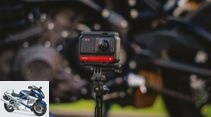
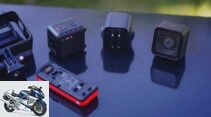
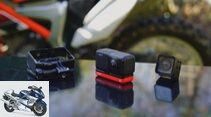
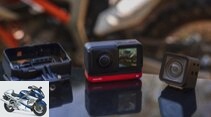
29 pictures
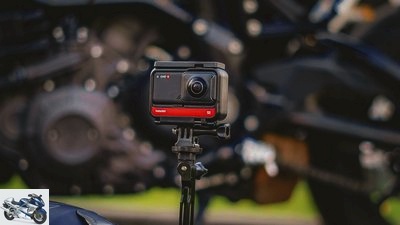
Tobias Beyl.
1/29
With the new One R, Insta360 brings a 360-degree camera the size of a standard GoPro. The One R is also the first modular action cam.

Tobias Beyl.
2/29
The camera is composed of a flat battery, a lens module and the core unit with memory, control buttons and touch display. This makes it possible to use different lens modules with the camera.
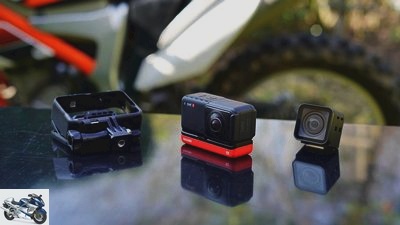
Tobias Beyl.
3/29
Here the camera is assembled as a 360-degree variant, on the right is the 4K module, which is also included in the Twin Edition, with which the One R films only in one direction, like normal action cams.
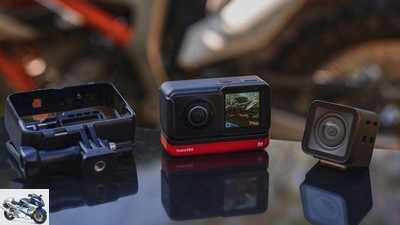
Tobias Beyl.
4/29
The 360-degree module, on the other hand, films in two directions. Since the two 180-degree shots create a complete all-round shot, it doesn’t really matter how the camera is aligned.
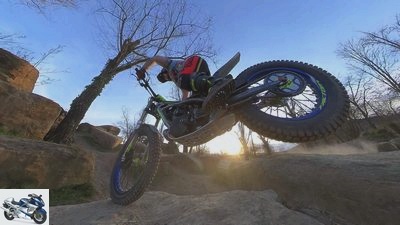
Tobias Beyl.
5/29
Thanks to the 360-degree recording, the desired image section can be conveniently selected afterwards. Here the very wide-angled view diagonally upwards.
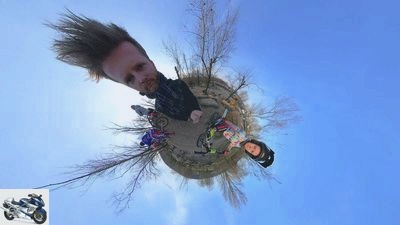
Tobias Beyl.
6/29
However, since the camera really films in all directions, merges the two recordings and automatically retouches the camera bracket, the user is completely free in post-production which perspective he chooses. Extreme views like this tiny planet effect are also possible.
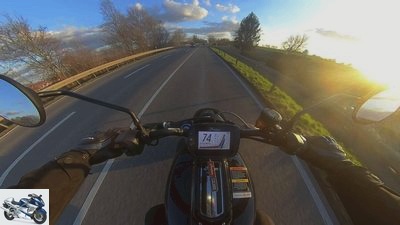
Tobias Beyl.
7/29
For motorcyclists, of course, the use on the motorcycle is interesting. Here the camera was attached a little in front of the driver’s chest and filmed in 360 degrees. In the free editing software, the view to the front was chosen, as is usual for motorcycle videos.

Tobias Beyl.
8/29
The view to the side would also be possible if, for example, the sunset or a mountain panorama are to be shown in the video.

Tobias Beyl.
9/29
A very wide-angled look back is also possible, for example to show the driver’s reaction. While these sample images all represent the same situation, the views in the editing program can of course also be varied one after the other.
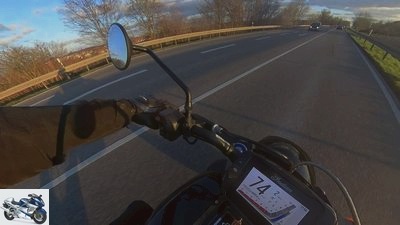
Tobias Beyl.
10/29
Keyframes can be used to animate the transitions between different image sections in the Insta360 Studio software. As a result, the view shown then rotates, for example, from looking back over the situation on the opposite lane forward.
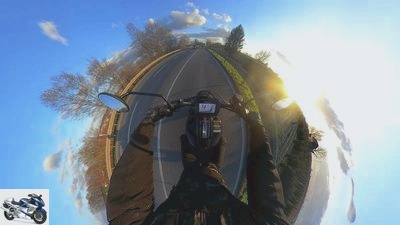
Tobias Beyl.
11/29
Thanks to the inclusion of a panoramic view, not only the direction of view, but also the viewing angle can be freely adjusted afterwards. An extreme fisheye view was chosen here.
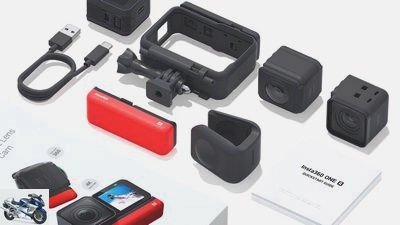
manufacturer.
12/29
The scope of delivery of the Insta360 One R in the twin edition includes: the main unit with display, memory and control buttons, the plastic frame with tripod or GoPro connection, the 360-degree camera module, the 4K camera module, a quick guide, a lens protector , the flat battery and a USB-C cable.
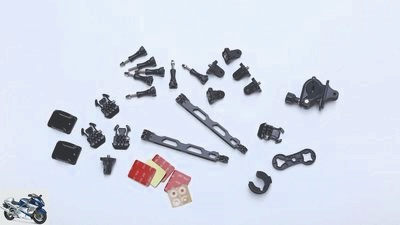
mps studio.
13/29
The motorcycle kit, which includes adhesive mounts, a handlebar clamp, extensions, screws and a practical tool, is available as an accessory package.
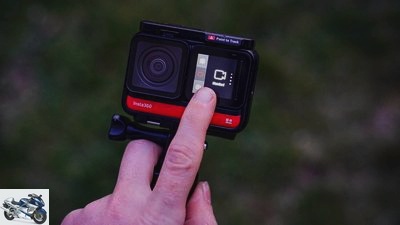
Tobias Beyl.
14/29
Compared to its predecessor, the slim Insta360 One X, the One R now has a real color display that can also be operated by touch. However, this only works without gloves.

Tobias Beyl.
15/29
Unfortunately, the camera shows a very narrow viewing angle when the 4K module is used. The GoPro’s supervision mode is more suitable for motorcyclists, or the 360-degree module on the One R..
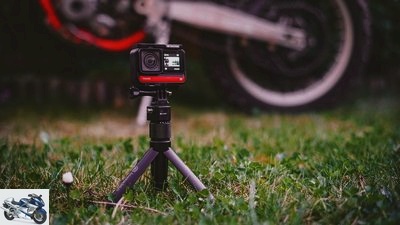
Tobias Beyl.
16/29
The possibility to mount the 4K camera module upside down is also practical. The camera and display then point in the same direction, which makes selfie or vlogging recordings easier.
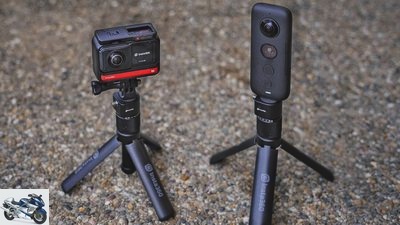
Tobias Beyl.
17/29
In a direct comparison with the Insta360 One X (right), the One R has more familiar dimensions and a more practical display. Otherwise they are very similar in terms of functionality. The mini tripod shown is available separately and is very useful in practice.

Tobias Beyl.
18/29
If you use the Invisible Selfie Stick (here in combination with a kidney belt with a tripod connection), unique recordings are possible. We hadn’t aligned the camera optimally, so the selfie stick wasn’t completely retouched from the picture. This is a still frame from a video recording.
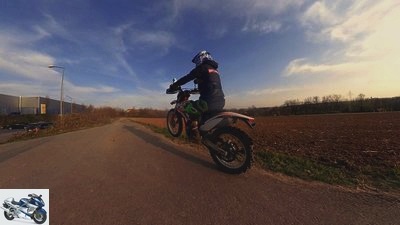
Tobias Beyl.
19/29
For this shot, the kidney belt with the attached selfie stick was simply turned a little further back. While the recordings offer great perspectives, this solution is not practical in road traffic (and also when driving enduro) and is rather dangerous.

Tobias Beyl.
20/29
Although the camera is attached to a bar that is almost a meter long, the image stabilization even copes well with vibrations and small jumps.
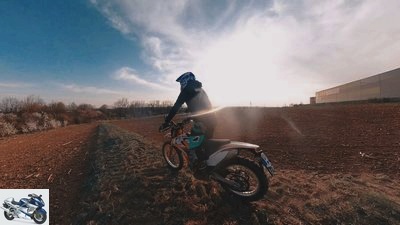
Tobias Beyl.
21/29
The Insta360 One R also offers the option of recording videos in log format. As a result, the recordings offer more options in post-processing, for example in terms of colors, contrasts, brightness and dynamics. The popular orange teal filter was used for this shot.
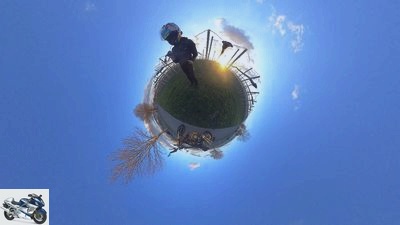
Tobias Beyl.
22/29
The less dangerous use of the camera and selfie stick is definitely off the bike. Then both detailed photos and landscape photos can be made, which can be edited in a variety of ways afterwards.

Tobias Beyl.
23/29
Also a very practical use: when the cameraman walks next to a motorcycle with the One R on the selfie stick. Then the camera can be relaxed and brought to positions that would normally be too close and dangerous. The 360-degree module then allows the desired perspective to be selected afterwards using software or an app.
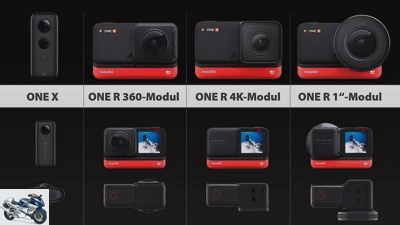
Tobias Beyl.
24/29
While the One X is simply a slim 360-degree camera, the One R’s camera module can be exchanged. The 360-degree module is certainly particularly interesting for motorcyclists, but the 1-inch module could also enable very appealing recordings on the motorcycle thanks to the larger sensor, especially in poor lighting conditions.
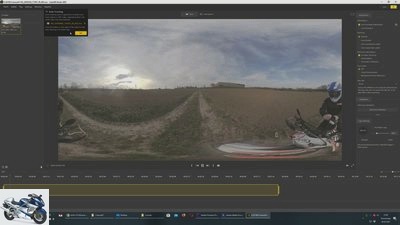
Tobias Beyl.
25/29
Insta360 regularly brings updates for the editing software and the apps, but unfortunately their functions still differ. Overall, software and apps turned out to be the major weaknesses of the One R, while the hardware is very convincing. App crashes and missing functions in the PC software, however, are nerve-wracking.
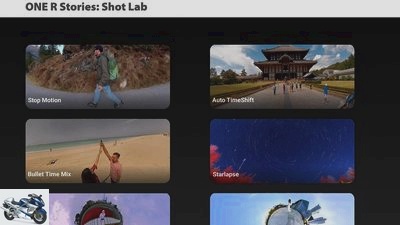
Tobias Beyl.
26/29
The ready-made options in the app are very practical. A short tutorial then explains which recordings are possible, a “Artificial intelligence” (or an image recognition algorithm) then selects the recordings accordingly and cuts them together into short videos. The Auto TimeShift function is interesting for motorcyclists, as it automatically picks out the important scenes from the 360-degree recordings, plays them back more slowly and selects the perspective accordingly.
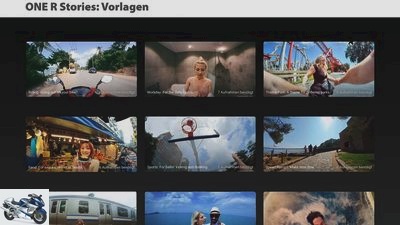
Tobias Beyl.
27/29
In addition to the Shot Lab, the app also offers templates that link individual videos in different ways and add fades. This works very well for short, entertaining films on a motorcycle tour – at least as long as the app doesn’t crash.
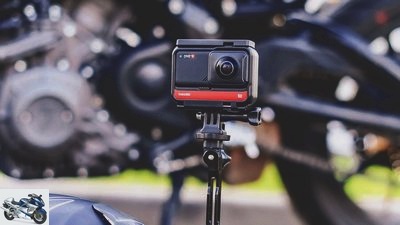
Tobias Beyl.
28/29
Overall, we liked the Insta360 One R very much, but the manufacturer urgently needs to work on the software. Then the One R – especially with the 360-degree module – offers great options for motorcyclists.
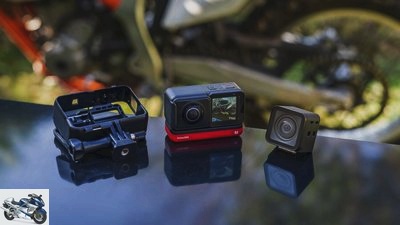
Tobias Beyl.
29/29
Further modules should be available in the future. The versatility offered by this also puts the not very cheap purchase price of the One R into perspective. In the Twin Edition shown, it costs 509 euros. On the one hand this is significantly more expensive than a GoPro Hero 8 Black (RRP 429.99 euros), on the other hand it is cheaper than a GoPro Max (RRP 529.99 euros) and definitely much cheaper than a GoPro Hero 8 Black plus a GoPro Max but both would be necessary to parry the versatility of the One R with its two camera modules.
accesories
Accessories A-Z
Insta360 One R in a practical test: 360-degree camera checked
Insta360 One R in a practical test
360 degree camera checked
The Insta360 One R is a 360-degree camera that wants to score with a lot of functions. How does the innovative action cam fare in a practical test?
Tobias Beyl
March 31, 2020
Last year Insta360 made a name for itself with the One X: A narrow and unusually elongated 360-degree camera that offers many functions and enables great recordings. Now the company, founded in 2014, is bringing the One R – with even more functions, more manageable dimensions and a special feature that no other action cam offers: a modular plug-in system that allows various lenses to be used. MOTORRAD was able to test the Insta360 One R in the Twin Edition with two lens modules in practice. Read our impressions of the new 360-degree camera here.
360-degree cameras as the evolution of the action cam
Action cams are popular with motorcyclists, be it to document their own heroic deeds or to record wrongdoing by others. Thanks to the technical advances made in recent years, action cams can now make great recordings, as numerous vloggers, Youtubers and Instagrammers have impressively demonstrated. However, action cams are usually attached to the helmet of motorcyclists and then film exactly where the driver is looking. That’s fine as long as the action is on and in front of the bike. However, the beautiful landscape is often to the left or right of the road. And dangerous situations with other road users sometimes arise from behind. Wouldn’t it be great if there was a camera that films front, back, left and right at the same time … and while we’re at it: also up and down. Just 360 degrees.
A camera that always films everything – that’s exactly what the Insta360 One R does. The relevant image section can then be selected afterwards by the post-producer or by the recipient while looking. A well-known example of the use of a 360-degree camera are the recordings made by Alex Hoffmann at the MotoGP racing events. To present the route, he attached a 360-degree camera to the rear of his Super Duke, and the recordings shown on television then appeared almost like from a computer game: no visible bracket, an extremely large field of view and very good image stabilization. All of this is also possible with the Insta360 One R – and if we are honest: many such functions were already in the predecessor, the One X. So where exactly are the differences??
The One R as the successor to the One X
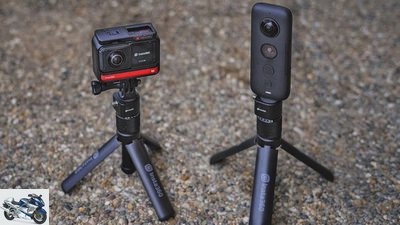
Tobias Beyl.
In a direct comparison with the Insta360 One X (right), the One R has more familiar dimensions and a more practical display.
The One X already performed very well in our practical tests, as it is intuitive to use and enables videos that are worth watching with little effort. Only the unusual shape and the modest battery life could be criticized. But it convinced with decent image quality, unusual perspectives, very good image stabilization and an impressive dynamic range.
It goes without saying that the One R, as its successor, wants to do everything at least as well – and, as our test shows, it actually does essentially. It also offers very good image quality and an impressive dynamic range, it also allows unusual perspectives and it too pleases with its very good image stabilization. At the same time, Insta360 has been working to resolve the aforementioned points of criticism. The battery now offers a little more capacity (1,190 instead of 1,050 mAh) and thus around ten minutes longer operating time, and an even larger battery will be available soon. The biggest difference between Insta360 One X and One R is the modular structure and the associated change in shape.
Differences between One X and One R.
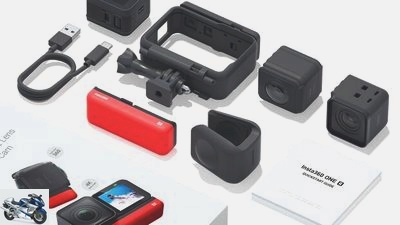
manufacturer.
Scope of delivery of the Insta360 One R..
Instead of the unusual 115 x 48 x 28 millimeters of the One X, the Insta360 One R now measures 72 x 48 x 32.4 millimeters, and is therefore roughly comparable to a GoPro Hero 8 (66.3 x 48.6 x 28.4 millimeters ). Another difference between the R and the X is the display: where the One X has a small black and white display to show the set mode, the One R is equipped with a real color screen that not only shows the live image, but All settings can also be changed via touch operation. This does not always work perfectly in practice, but it does work quite well – at least if you have memorized the various swiping gestures and their functions. In most cases, however, operation via a smartphone app is more effective. As with the One X, the One R also has its own app, each for Android and iOS. The connection between the camera and smartphone works via WLAN, the range is just under ten meters. All settings can then be made in the app, including a live preview. Live streaming is currently not possible, which already works with the One X. But this function should come soon. If you use the One R in conjunction with the smartphone app (or alternatively an Apple watch or the optionally available smart remote), its GPS data is included in the video. This allows information such as speed or inclination to be displayed afterwards. Unfortunately, the One R itself does not have a GPS module.
What the One R does not have, unlike the One X, is an integrated tripod connection. Since the modular One R should actually only be used in conjunction with the mounting frame and this has a ¼-inch connection for tripod screws, this is not a major problem. At the same time, this frame naturally makes it a bit cumbersome to swap the camera modules or to remove the micro SD card. This is now hidden behind a small cover, while on the Insta360 One X it was pushed in without protection on the underside. This goes hand in hand with water protection on the new One R that promises airtightness of up to five meters; in combination with the optionally available dive case even up to 60 meters. We couldn’t test that – hello, who goes swimming on their motorcycle ?! -, but when driving in the rain, the One R was completely unimpressed. Regardless of whether the 360-degree module or the 4K wide-angle module was used. In the next section we will explain what exactly is behind these interchangeable modules.
Unique selling point of the One R: its modularity
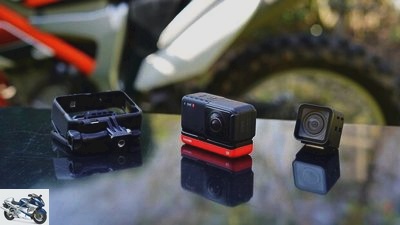
Tobias Beyl.
Here the camera is assembled as a 360-degree variant, on the right is the 4K module, which is also included in the Twin Edition.
The Insta360 One R essentially consists of three parts. First the flat, red battery. This also forms the basis on which one of the currently three available lens modules is attached, as well as another module that houses the processor, the memory unit, control buttons and the display. The One R is available in different versions, which differ in terms of the lens modules in the scope of delivery. The Twin Edition we tested includes the 360 degree module with two lenses and the 4K module. A lens unit with a larger and therefore more powerful sensor is also currently available. It was developed in collaboration with Leica and, with its 5.3K videos, should again significantly increase the quality of action cam videos you are used to. This 1-inch edition costs € 599.99 as a complete set, € 829.98 in the trio edition with the two other camera modules and € 319.99 as a single add-on. The twin edition we tested is € 509.99, the pure 360 edition € 489.99 and the pure 4K version € 339.99.

Tobias Beyl.
While the One X is simply a slim 360-degree camera, the One R’s camera module can be exchanged.
The 4K edition of the One R largely corresponds to the capabilities of a GoPro, and the camera also has image stabilization and slow motion capabilities. Unfortunately, the angle of view is not as wide as with the GoPro in Superview mode, which is very useful for motorcyclists and for use as a helmet camera. In our opinion, this means that you don’t see enough of the motorcycle and its surroundings, which is why we will mainly focus on the 360-degree module below. How the One R with a 4K module performs against the GoPro in practice is what ours go for Austrian colleagues from 1000PS in detail. We liked the option of displaying GPS data in post-production. However, this assumes, firstly, that the app does not crash while editing (which it regularly did) and, secondly, that the recording was started from the smartphone so that the GPS information from the mobile phone can be integrated into the recording.
For motorcyclists, the 360-degree module is definitely the more sensible investment, as it enables a wide variety of recordings to be made with little effort. In the following clip, the camera was attached a little in front of the driver’s chest; all changes in perspective, viewing direction and angle of view were only selected afterwards in the software on the PC.
Before we go into the peculiarities and special features of the One R with the 360-degree attachment, the technical data of the camera are presented at this point. The following table therefore provides information on how the different versions of the One R differ from one another and also from the predecessor One X..
Insta360 One R Specifications
| Insta360 One X | Insta360 One R (4K module) | Insta360 One R (360 degree module) | Insta360 (1 inch module) | |
| Video resolution | 5.7 K (5760 x 2880) at 30 fps; 3840 x 1920 at 50 fps; 3008 x 1504 at 100 fps | 4000 x 3000 at 30 fps; 3840 x 2160 at 60 fps, 2720 x 1530 at 100 fps, Full HD (1920 x 1080) at 200 fps | 5.7 K (5760 x 2880) at 30 fps; 3840 x 1920 at 50 fps; 3008 x 1504 at 100 fps | 5312 x 2988 at 30 fps; 3840 x 2160 at 60 fps; Full HD (1920 x 1080) at 120 fps |
| Video modes | 360 video, time lapse, bullet time, HDR video | Standard video, time lapse, time shift mode, HDR video | 360 video, time lapse, bullet time, HDR video | Standard video, time lapse, time shift mode |
| Video format | insv, mp4; H264 | insv, mp4; H264 or H265 | insv; H265 | insv, mp4; H264 or H265 |
| Live streaming | possible | should come | should come | should come |
| Photo resolution | 18 MP (6080 x 3040) | 4000 x 3000; 4000 x 2250 | 6080 x 3040 | 5312 x 3552; 5312 x 2988 |
| Photo modes | 360 photos, time-delayed, HDR, interval, RAW | Standard, HDR, Burst, Interval, Night Shot | 360 photos, HDR, burst, interval, night shot | Standard, HDR, Burst, Interval, Night Shot |
| Focal length (equivalent to 35 mm) | n / a. | 16.4 mm | 7.2 mm | 14.4 mm |
| cover | 2.0 | 2.8 | 2.0 | 3.2 |
| Exposure time | 1/8000 to 55 seconds | 1/8000 to 120 seconds | 1/8000 to 120 seconds | 1/8000 to 120 seconds |
| ISO sensitivity | 100-3200 | 100-3200 | 100-3200 | 100-3200 |
| Dimensions | 115 x 48 x 28 | 72 x 48 x 32.4 | 72 x 48 x 43 | 78.7 x 53.8 x 47.2 |
| Weight | 115 grams | 121 grams | 130.5 grams | 158.2 grams |
| Bluetooth | 4.0 | 4.0 | 4.0 | 4.0 |
| Wi-fi | 5G | 5G | 5G | 5G |
| USB | Micro USB | Type c | Type c | Type c |
| Memory card | Micro SD up to 256 GB | Micro SD up to 256 GB | Micro SD up to 256 GB | Micro SD up to 256 GB |
| battery pack | 1050 mAh | 1190 mAh | 1190 mAh | 1190 mAh |
| Loading time | 100 minutes | 65 minutes | 65 minutes | 65 minutes |
| Operating time | 60 minutes | 70 minutes | 70 minutes | 65 minutes |
| Insta360 One X | Insta360 One R (4K module) | Insta360 One R (360 degree module) | Insta360 (1 inch module) | |
| Video resolution | 5.7 K (5760 x 2880) at 30 fps; 3840 x 1920 at 50 fps; 3008 x 1504 at 100 fps | 4000 x 3000 at 30 fps; 3840 x 2160 at 60 fps, 2720 x 1530 at 100 fps, Full HD (1920 x 1080) at 200 fps | 5.7 K (5760 x 2880) at 30 fps; 3840 x 1920 at 50 fps; 3008 x 1504 at 100 fps | 5312 x 2988 at 30 fps; 3840 x 2160 at 60 fps; Full HD (1920 x 1080) at 120 fps |
| Video modes | 360 video, time lapse, bullet time, HDR video | Standard video, time lapse, time shift mode, HDR video | 360 video, time lapse, bullet time, HDR video | Standard video, time lapse, time shift mode |
| Video format | insv, mp4; H264 | insv, mp4; H264 or H265 | insv; H265 | insv, mp4; H264 or H265 |
| Live streaming | possible | should come | should come | should come |
| Photo resolution | 18 MP (6080 x 3040) | 4000 x 3000; 4000 x 2250 | 6080 x 3040 | 5312 x 3552; 5312 x 2988 |
| Photo modes | 360 photos, time-delayed, HDR, interval, RAW | Standard, HDR, Burst, Interval, Night Shot | 360 photos, HDR, burst, interval, night shot | Standard, HDR, Burst, Interval, Night Shot |
| Focal length (equivalent to 35 mm) | n / a. | 16.4 mm | 7.2 mm | 14.4 mm |
| cover | 2.0 | 2.8 | 2.0 | 3.2 |
| Exposure time | 1/8000 to 55 seconds | 1/8000 to 120 seconds | 1/8000 to 120 seconds | 1/8000 to 120 seconds |
| ISO sensitivity | 100-3200 | 100-3200 | 100-3200 | 100-3200 |
| Dimensions | 115 x 48 x 28 | 72 x 48 x 32.4 | 72 x 48 x 43 | 78.7 x 53.8 x 47.2 |
| Weight | 115 grams | 121 grams | 130.5 grams | 158.2 grams |
| Bluetooth | 4.0 | 4.0 | 4.0 | 4.0 |
| Wi-fi | 5G | 5G | 5G | 5G |
| USB | Micro USB | Type c | Type c | Type c |
| Memory card | Micro SD up to 256 GB | Micro SD up to 256 GB | Micro SD up to 256 GB | Micro SD up to 256 GB |
| battery pack | 1050 mAh | 1190 mAh | 1190 mAh | 1190 mAh |
| Loading time | 100 minutes | 65 minutes | 65 minutes | 65 minutes |
| Operating time | 60 minutes | 70 minutes | 70 minutes | 65 minutes |
Everything in view at all times
360 degree recordings do not necessarily have to be viewed with VR glasses. Even if it is very attractive as a viewer to be able to decide for yourself where you want to look, in practice this type of video will probably only make up a part of the productions. Instead, it is the video producer himself who benefits from this option: He no longer has to decide in advance where to point the camera. To the front to be able to film the street? Or is it to the side to show the breathtaking landscape? Or possibly with a view back from the handlebars, in order to be able to depict yourself in full format?
The main advantage of 360 degree recordings compared to the usual, GoPro-typical, ultra-wide-angle recordings in 16 to 9 format is: The desired perspective and the appropriate format can be selected afterwards without any problems, in post-production. The One R takes advantage of this particularly in connection with the optionally available Invisible Selfie Stick, which the software automatically retouches from the recordings. The One R is simply attached to the end of this stick and then brought close to what is to be filmed. This can be the speedometer or your own rear wheel, but it can also be someone else who you want to film from a reasonably safe distance, for example while trialing.
In such a situation, it is exhausting enough to walk next to the trial motorcycle and point the camera in the right direction. Then also having to make sure that the camera is pointing in the right direction is almost impossible. With the 360-degree camera, on the other hand, it is no problem at all to always select exactly the right image section afterwards. Thanks to a total resolution of 5.7 K (5760 x 2880 pixels) at 30 frames per second, zooming in in post-production is also possible without sacrificing quality. It looks different if you want to use slow-motion recordings: 100 fps, which enables a four-fold slowdown in post-processing, the camera only records with 3008 x 1504 pixels. The slow-motion effect looks quite pixelated if you select a somewhat narrower image section. This is shown very well at the beginning of the following clip:
The advantages of the 360-degree module
Of course, the Insta360 One R can also be used as a normal helmet camera, but here too the 360-degree module is much more versatile than the 4K attachment. In addition, more impressive recordings are possible if the camera is not attached directly to the helmet, but rather at a distance. In the following shot, the two extensions included in the motorcycle bundle were used between the camera and the helmet attachment. As a result, the One R floats a little above the head and thus enables more beautiful perspectives than if the camera is attached directly to the helmet and this is always seen in the picture in a disturbing way.
From an aerodynamic point of view and in terms of safety, this attachment is of course rather questionable. That’s why we didn’t take most of our recordings in public traffic. In particular, we would never film the other examples on the street, as the invisible selfie stick, which is about one meter long, was always used. As the following video shows, it is indeed possible to take one-off shots, but it also increases the dimensions of the motorcycle considerably. In addition, the combination of typical motorcycle vibrations and a very long lever arm significantly increases the risk of losing the camera.
LOG, LUT and the look of a video game
If you noticed the bland colors in the clip just shown: The One R allows recordings in the so-called log format. This allows a much larger dynamic range to be recorded, but requires post-processing on the PC. Insta360 offers a specially developed LUT (lookup table), which can be used for color grading in the Adobe Premiere editing program, for example, and corrects the colors and contrasts accordingly. The video then looks like our following example, in which, despite direct backlighting, the image is neither overexposed nor the dark areas of the image lose their details:
One type of recording that should be reasonably safe in public traffic, but which the race management will certainly not like too much, is the use with a special kidney belt. The invisible selfie stick can then be attached to this, which does not necessarily have to be pulled out to its full length. The resulting recordings have the computer game look mentioned above and are reminiscent of games like Grand Theft Auto.
Of course, these recordings can be edited afterwards on a PC or Mac as well as on a smartphone. It is annoying that the various systems sometimes offer different functions, but the choice of viewing direction and field of vision is possible everywhere. This means that different views can be used even if the position of the camera has not changed. In the following video clip, the One R is again attached to the driver’s back with a selfie stick, but in addition to the third-person view, the Tiny Planet function is also used here.
Impressive image stabilization
While the image stabilization of the 4K module is good, but not quite as good as that of the GoPro Hero 8 Black, the Insta360 One R with the 360-degree attachment is very unaffected by vibrations. In the following video example we have again attached the camera to the special kidney belt using an invisible selfie stick, this time not pointing backwards, but at an angle forwards and slightly downwards. Of course, this camera position would limit the possible inclination very much, but we were only interested in checking how the One R, which is attached to a long lever, deals with the vibrations that occur during a wheelie and how it reacts to an emergency braking.
Despite the vibrations, the camera offers a very calm recording. On the other hand, the bright right image area is slightly annoying: Since one lens of the camera was directed more towards the front and the other towards the rear, only the rear lens had to deal with backlighting. This is where the so-called stitching comes about “Sewing together” or joining the two individual images together to form a clearly perceptible dividing line. In this example it is again noticeable that the GPS data is unfortunately not synchronized with the video. There are several seconds between a visible stop and the reaction of the speedometer.
Also noticeable: the rather poor sound quality of the Insta360 One R. Although the main module with the integrated display has two microphones, these are extremely susceptible to wind noise and vibrations. Even at slow speeds, as in the next example video, the motor can hardly be heard, instead cracking noises and hissing come to the fore. This could soon be remedied by an external microphone that can be used via the USB-C port integrated in the camera. Much more exciting, however, is the promised possible use of Bluetooth microphones. Insta360 promises to do this, but it will still take a while. In the meantime, engine noises or your own comments for the vlog should be recorded using a separate recording solution.
Picture hui, sound ugh. And the software?
In addition to the poor sound quality at fast and slow speeds, this video also clearly shows: The advantages of the Insta360 One R are indeed not in the audio area, but in the visual area. Not only does the camera have a sufficiently high resolution, relatively good stitching and an impressive dynamic range, but the option of variably selecting a perspective afterwards also makes a good impression. Of course, the camera only provides the raw material for this, the rest of the work is done by software. It does not matter whether the Insta360 Studio on the PC or the corresponding app on the smartphone, they all offer several prefabricated image angles such as fisheye, wide angle, natural or tiny planet. The viewing direction is selected in the software by clicking and dragging the mouse, then keyframes must be created in FreeCapture mode. Insta360 also promises the use of artificial intelligence that automatically stages the best scenes in the best possible way, but unfortunately this function is not yet available in the PC software. This function is available on the smartphone, and templates and the so-called shot lab are also integrated:
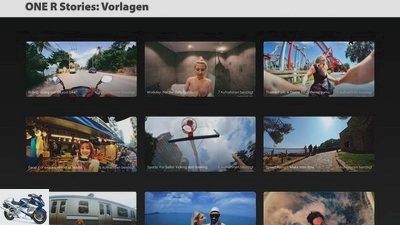
Tobias Beyl.
In addition to the Shot Lab, the app also offers templates that link individual videos in different ways and add fades.
These templates combine selected video snippets in different ways, just as it suits the chosen purpose. This makes it possible, for example, to create an impressive video in the shortest possible time after a motorcycle tour – or rather: have it created. The app connects the recordings with suitable transitions, and the length and speed of the clips are selected appropriately.
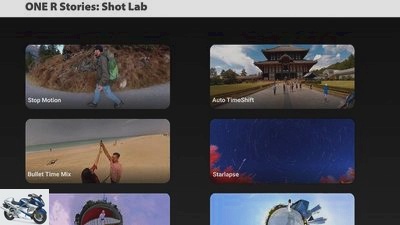
Tobias Beyl.
The ready-made options in the app are very practical.
Another highlight of the app is the so-called Shot Lab. Special recordings are possible here that would require in-depth video editing experience without the support of the app. For motorcyclists these are unfortunately only partly of interest, since most of the possibilities require a standing, jumping or running person, but Auto TimeShift and Starlapse can also be exciting for bikers.
Of course it is to be expected that with the appearance of the camera the social media will be saturated with exactly these pre-made shots, but it is always a nice gimmick.
Actually, the stars in this shot were supposed to draw continuous lines, but we were already happy that a usable video was made at all. Because – and this is our big criticism of the One R – the apps were extremely unreliable. The differences between the Android and iOS versions are also confusing. In the Apple version, the Star Trails can be switched on or off, in the Android version of the app they are always on. The scanning of recordings by the so-called artificial intelligence also took different lengths of time in the two apps. Or actually: the Android app was partially not ready after more than twelve hours, where the iOS app only took about twelve minutes. A similar picture emerged when exporting. But that doesn’t mean that the Android app is worse per se than the iOS version, because both apps very regularly shut down by themselves, regardless of whether they were asked to do something more complex or just play a video. In our test, this resulted in so many moments of frustration that we ultimately only edited the videos on the PC. However, some of the functions that make the apps so special are missing here. For example, the GPS data stored in the video clips cannot be displayed, which is of course a great function, especially for motorcyclists. It is also not possible to adjust the playback speed in the PC software. Another advantage of the apps over the PC software is the use of the gyro sensor integrated in the smartphone. Thus there can be the perspective “on the fly” can be selected when playing the video by simply rotating and tilting the smartphone. Keyframes have to be created on the PC and then the transitions between them have to be adjusted. The following video example shows that this can also work:
Further problems
Operation via the touchscreen is a bit fiddly, but at least feasible without gloves. Operation via the app works well. And the operation via voice commands is bad. In fact, we only managed once during our tests to get the camera to take a photo at our word. We already mentioned the app crashes, but they were so frequent and annoying that we like to criticize them a second time. The mediocre sound quality has also already been mentioned. In addition, the camera is not very informative about whether the recording is currently in progress or not. Because after a short time the display normally switches off (but can be deactivated), but the LED on the front does not indicate whether the recording is in progress or not. Since the recording regularly stops, especially with a memory card that is too slow, a hint here would be nice. Another small point of criticism is the fact that the camera would like to hang on to the power for a good ten minutes when the battery is empty, until it does not switch off again immediately after being switched on. This time span could be a little shorter.
Where there is a lot of shadow, there has to be light
In fact, most of the criticisms relate to the software or apps and their reliable use on the smartphone. We used an iPhone 8 with iOS 13.4 and the Xiaomi Mi 9 Lite with Android 9. It is certain that Insta360 will quickly improve this with updates. As far as the PC software is concerned, its range of functions will certainly be expanded. In this respect, we hope that the criticism of the software is only a temporary snapshot. And that brings us to the real strengths of the Insta360 One R, namely the hardware on the one hand and the quality of the recordings on the other. The 4K module could not completely convince us because the viewing area is a bit too narrow. On the other hand, we liked the fact that it can be combined with the main unit in both directions so that the display either faces back as usual or faces the same direction as the lens. This is particularly useful when vlogging or taking selfies.
The 1-inch module developed with Leica also arouses our curiosity and the 360-degree module works very well in practice. The prospect of further modules in the future, for example a larger battery, makes the modularity of the One R all the more valuable. Meanwhile, the 360-degree module not only impresses with its enormous versatility in terms of the subsequent selection of the perspective, it also offers sufficient resolution and a high dynamic range. Attaching it to the motorcycle or helmet is a bit more complicated in order to be able to use its full potential, but then recordings are possible that cannot be achieved with a normal action cam. Since the direction of view and image detail can only be selected afterwards, the camera can be safely forgotten while driving, on the other hand, several different videos can be generated from one recording if necessary: sometimes looking ahead, sometimes looking back at the driver. And sometimes with a view to the side towards the sunset or mountain panorama.
Further information
The Insta360 One R is available at a slightly reduced price as a motorcycle kit until April 12th. The One R is included as a twin edition, i.e. with a 4K lens and 360-degree module, plus the invisible selfie stick, a 32 GB micro SD card and the complete motorcycle bundle. This in turn consists of numerous brackets, adapters, adhesive surfaces, extensions and a useful tool for tightening and loosening the screws. Further information is available at https://store.insta360.com/onermotorbike.
Conclusion
The Insta360 One R is a further development of the One X. Its range of functions is clearly better, its range of applications broader. Anyone who owns the Insta360 One X and is happy with it will have no reason to upgrade. However, if you want to immerse yourself in the world of 360-degree recordings and are also pleased about the possibility of using the One R as a normal action cam (or in the future with the 1-inch module, thanks to its modular structure with the 4K module to be able to use it as a special action cam), you get a good overall package at a not very cheap, but still reasonable price. The Insta360 One R impresses most with the image quality of its 360-degree recordings and the versatility of the recordings. On the other hand, points are deducted for crash-prone apps and PC software, which unfortunately cannot replace all of the app’s functions. We hope for a quick improvement by Insta360, which shouldn’t be a problem with software and firmware updates.
Related articles
-
Practical test: clothing and accessories for touring riders
Bilski clothing Station wagons, jackets & pants Practical test: clothing and accessories for touring riders Practical test: clothing and accessories for…
-
Eleveit Strade: motorcycle leather jacket for women in a practical test
Ferdinand Heinrich 17th pictures Ferdinand Heinrich 1/17 The Eleveit Strade leather jacket costs around 300 euros. They are available for women in…
-
Practical test of the Shoei XR 1000 helmet
Shoei clothing Helmets Practical test of the Shoei XR 1000 helmet Practical test of the Shoei XR 1000 helmet Jack of all trades? Shoei’s most successful…
-
Practical test Nuviz head-up display for motorcyclists
Louis 19th pictures Louis 1/19 According to the manufacturer, the Nuviz head-up display weighs 240 grams. Louis 2/19 Nuviz head-up display for…
-
Practical test: Enduro equipment
Brodbeck clothing Station wagons, jackets & pants Practical test: Enduro equipment Practical test: Enduro equipment Off road A week on the Enduro in the…
-
Practical test of summer suits
Artist clothing Station wagons, jackets & pants Practical test of summer suits Practical test of summer suits Aviation After the extremely hot summer of…
-
Rain suit Held Rainblock in a practical test
Tobias Beyl 8th pictures 1/8 Tobias Beyl 2/8 But they are also available in a more muted tone with extensive black. Tobias Beyl 3/8 The jacket is…
-
Buse Ferno leather-textile driver’s suit in a practical test
Baumann 10 pictures Baumann 1/10 If leather is not always supposed to / has to be, but a pure textile suit is also out of the question, the Buse Ferno…
-
Sena 7th pictures Sena 1/7 In the test, the Sena Prism Tube Wifi impressed with its generous recording modes. Sena 2/7 The operation can be described as…
-
Practical test: gasoline consumption
counselor workshop Practical test: gasoline consumption Practical test: gasoline consumption Consumption advice Work makes you thirsty. That applies to…